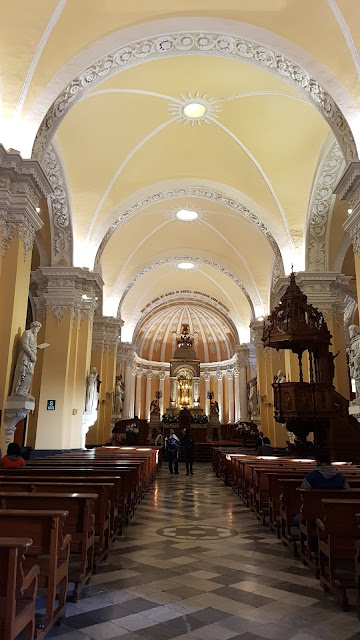I arrived Arequipa from an overnight luxurious bus where I slept the whole night. Vellocito Backpackers where I have made a reservation informed that taxi from the bus station to their hostel cost about 8-10 soles. I ended up in one that charged S/10 (~USD 3 / ~AUD 4.50 / ~RM 12.50. I wasn't thinking right or I would've bought my bus ticket to Ica before I left the station. Anyway all was well, I ended up getting the ticket from one of the travel agencies in Arequipa city and not charged any handling fee.
Arequipa is surrounded by a trio of volcanoes - Misti, Mount Chachani and Pichu Pichu Peak. Misti sits in between the other two and comes from the Quechua language meaning "The Gentleman". Most of the colonial buildings in Arequipa were built using the white rock from the volcanoes known as sillar. So Arequipa is a white city. Cusco, on the other hand, is mainly brown in colour.
There were 2 stories on how Arequipa was named. The first was from Aymara language where it means a summit laying behind, with "ari" for summit and "quipa" for "laying behind". The second was about Inca Mayta Capac, the fourth Inca amazed by the beauty of the place and told his troops to stay "Ari, quipay" which means "Yes, stay!" Not sure how true are the stories but all the white buildings around, as well as the nearby El Misti volcano certainly making Arequipa looks bright and welcoming.
If you look at the photography carefully, you'll notice that you can get a photo of both El Misti and Basilica Cathedral of Arequipa in this Plaza de Armas. Basilica Cathedral forms the main building in Arequipa's Plaza de Armas and flanked by more white stone buildings on both sides. These buildings house cafe, restaurants, tour offices, etc.
The first Basilica Cathedral was first built in 1540. Over centuries, the church was damaged by earthquakes and volcanic eruptions. The clock tower holds an imported clock from England dated back from the 19th century. In the interior, the impressive organ was from Belgium.
The church was not open when I first arrived in Arequipa but I was lucky on the day I returned from Cabanaconde. I had some time before hopping on a bus to Ica and on my random stroll, I notice that it was opened to public, naturally I went in. :)
I actually did a walking tour based on a guide book and the nearest recommended building from Plaza de Armas (aside from Basilica Cathedral) is Iglesia de la Compania de Jesus. It is just off the Plaza de Armas. This church was also built using sillar stone with construction plan from Spain but included influence of Andean motifs. I remembered standing outside a chifa restaurant (chifa is a culinary fusion of Chinese Cantonese and traditional Peruvian) across the road from the church taking photos.
I also spent some time at Monasterio de Santa Catalina and I was surprised myself that I didn't even take one single photo using my phone, which means no photos.
Monasterio de Santa Catalina was founded by a rich young widow named María de Guzmán back in 1579. She was also the first habitat of this mini-city monastery. After that the church welcomed and housed up to 500 nuns in its complex. The monastery complex was about 20,000 square metres. Santa Catalina was also built from sillar stone but the walls are painted in earthy red or sky blue depending on the location. The entrance fee wasn't cheap though, at S/40 (~USD 12/ ~AUD 17 / ~RM 49).
 |
| From Mirador de Yanahuara |
 |
| From bridge |
Arequipa is also famous for queso helado (S/3) which literally means cheese ice-cream but it didn't taste cheese but milk. I was also told it is made from milk, so, not sure why it isn't call milk ice-cream instead.
The other snack I tried in Arequipa was humita (S/1) (steamed corn cake). Humitas are wrapped in banana leaves but the seller will take them off and put in a plastic bag for easier consumption. The one I had is a sweet version.
Side note: Other place that is usually recommended is Museo Santuarios Andinos (Andean Sanctuaries Museum). This museum houses a preserved more than 500 years Inca girl Juanita who was discovered at the foot of a mountain.





0 comments